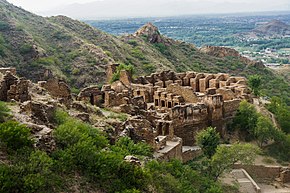Takht Bhai

Takht-i-Bahi
|
|
| Location | Mardan, Khyber Pakhtunkhwa, Pakistan |
|---|---|
| Coordinates | 34°19′15″N 71°56′45″E / 34.32083°N 71.94583°ECoordinates: 34°19′15″N 71°56′45″E / 34.32083°N 71.94583°E |
| Type | Settlement |
| History | |
| Founded | 1st century CE |
| Abandoned | 7th century CE |
| Official name | Buddhist Ruins of Takht-i-Bahi and Neighbouring City Remains at Sahr-i-Bahlol |
| Type | Cultural |
| Criteria | iv |
| Designated | 1980 (4th session) |
| Reference no. | 140 |
| Region | Asia-Pacific |
Takht-i-Bahi (Urdu: تخت باھی; Throne of the water spring), also commonly mispronounced as Takht-i-Bhai ("Brother's throne"), is a Parthian archaeological site of an ancient monastery in Mardan, Khyber-Pakhtunkhwa, Pakistan. The monastery was first a Zoroastrian complex which, after the later arrival of Buddhism, was then converted into a Buddhist monastic complex.
The site dates to the 1st century CE. The complex is regarded by archaeologists as being particularly representative of the architecture of Buddhist monastic centers from its era. Takht-i-Bahi was listed as a UNESCO World Heritage Site in 1980.
The word Takht-i-Bahi may have different explanations. Local believes that site got its name from two wells on the hill or the springs nearby. In Persian, Takht means "top" or "throne" while bahi means "spring" or "water". When combined together its meaning is Spring from the Top or High Spring, and there were two springs on the top of mountains. Another meaning suggested is Throne of Origin.
The ruins are located about 15 kilometers from Mardan in Pakistan's Khyber-Pakhtunkhwa Province. A small fortified city, dating from the same era, sits nearby. The ruins also sit near a modern village known by the same name. It is located around 500 feet atop the small hill and around 2 km from village bazar. The surrounding area is famous for sugar cane, wheat, maize, vegetable, and orchard cultivation.
There are four main areas of the Takht Bahi complex:
Additional structures on the site may have served as residences or meeting halls, or for secular purposes. All of the buildings on the site are constructed from local stone, and are mortared with lime and mud.
Archaeologists have divided the history of the complex into four periods, beginning in the 1st century BCE.
The monastic complex was likely founded in the early 1st century CE. It is proven by an inscriptions found bearing the name of Gondophares (20-46 CE). After Gondophares, the place fell under control of Kujula Kadphises, the first Kushan king. This first era continued until the 2nd century CE, and is associated with another Kushan king Kanishka, as well as early Parthian and later Kushan kings. The second construction period, which included the creation of the Stupa Court and assembly hall, took place during the 3rd and 4th centuries CE. A third construction period, associated with the later Kushan dynasty and the Kidara Kushana rulers, occurred during the 4th and 5th centuries. The final construction period, which saw the creation of the so-called Tantric complex, took place in the 6th and 7th centuries CE, and was overseen by invading Hun rulers.
...
Wikipedia

